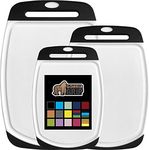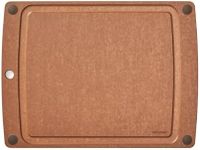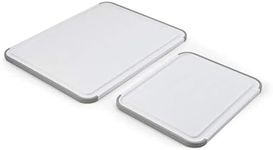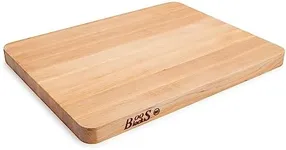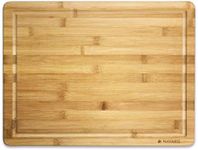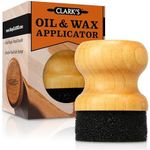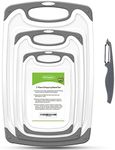Buying Guide for the Best Cutting Boards
Choosing the right cutting board is important for both your cooking experience and kitchen hygiene. A good cutting board protects your knives, keeps your food safe, and makes meal prep easier. When picking a cutting board, think about what types of food you prepare most often, how much space you have, and how easy you want cleaning to be. Understanding the key features will help you find a board that fits your needs and lasts a long time.MaterialThe material of a cutting board affects its durability, how it treats your knives, and how easy it is to clean. Common materials include wood, plastic, bamboo, and composite. Wood boards are gentle on knives and look attractive, but require more care and are not dishwasher safe. Plastic boards are lightweight, easy to clean, and dishwasher safe, but can develop deep grooves over time. Bamboo is harder than wood and more eco-friendly, but can be tough on knives. Composite boards combine durability and easy maintenance, but may be pricier. If you want something easy to clean and low-maintenance, plastic or composite is a good choice. If you value aesthetics and knife care, wood might be best. Think about your cooking habits and cleaning preferences to decide.
SizeThe size of a cutting board determines how much space you have to work with and how easy it is to store. Small boards are great for quick tasks like slicing fruit or cheese, while medium boards are versatile for most home cooking. Large boards provide plenty of space for chopping big items or preparing multiple ingredients at once, but they take up more storage and counter space. If you often cook large meals or prep lots of ingredients, a bigger board is helpful. For small kitchens or simple tasks, a smaller board is more practical. Consider your kitchen space and typical meal prep when choosing the right size.
ThicknessThickness affects the stability and durability of a cutting board. Thicker boards are sturdier and less likely to warp, making them ideal for heavy-duty chopping. Thinner boards are lighter and easier to move or store, but may slide around or wear out faster. If you do a lot of heavy chopping or want a board that lasts, go for a thicker option. For light tasks or easy handling, a thinner board may be enough. Match the thickness to your cooking style and how much you move your board around.
Surface TextureThe surface texture of a cutting board can impact how food and knives interact with it. Smooth surfaces are easy to clean and good for most tasks, but can become slippery. Textured or grooved surfaces help keep food in place and may catch juices, which is useful for cutting meat. If you mostly cut vegetables or bread, a smooth surface is fine. If you prepare a lot of juicy foods or meats, look for a board with grooves or a juice well to keep your counter clean.
MaintenanceMaintenance refers to how much care a cutting board needs to stay in good shape. Some boards, like wood, need regular oiling to prevent drying and cracking, while plastic and composite boards are usually dishwasher safe and low-maintenance. If you prefer a board that you can just toss in the dishwasher, plastic or composite is best. If you don’t mind a little extra care for a beautiful board, wood is a good choice. Think about how much time you want to spend on upkeep when making your decision.
